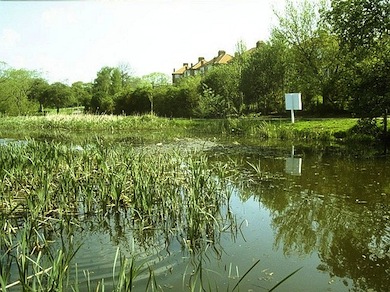The Deans Brook runs for just over two kilometres from where it emerges from a culvert under the M1 motorway, through Stoneyfields Park and suburban Edgware, to join the Silk Stream near Edgware Hospital. This site also includes an area of allotments to the east, and wetland and railside land to the south of the Edgware station sidings. In addition to the brook, habitats on this site include a lake, woodland, hedgerows and grassland, most of which is found in the park. The only accessible part of this site is Stonyfields Park, although good views of the wetland to the south of Edgware station can be had from trains between Edgware and Burnt Oak.
Local Wildlife Site
Accessible Sites of Importance for Nature Conservation
Deans Brook and Stoneyfields Park
Borough: Barnet
Grade: Borough Grade II
Access: Free public access (part of site)
Area: 11.17 ha
Description
Wildlife
The stream largely follows its natural, sinuous course, but most of the banks are restrained by wooden toe-boards. It is heavily shaded by narrow strips of woodland for much of its length, and there are few plants in the water. Kingfishers and grey wagtails are regularly seen along the brook. In Stoneyfields Park, the brook has been widened into an ornamental lake. This has a wide fringe of tall plants growing out of the water. These are dominated by great and lesser reedmace, with yellow iris, great willowherb, gypsywort, water mint and wild angelica. Coots, moorhens and mallards breed on the lake, which also supports amphibians and dragonflies. The woodland in the park is of oak and hazel. Some of the hedges are clearly old, and contain plants indicative of ancient woodland, such as wood-sedge and ramsons. Some of the grassland is quite herb-rich, with wild flowers such as cuckooflower.Facilities
Playground (in Stonyfields Park).
View of Stoneyfields Park © Jim Rea
Feedback
Have a question or a comment for this site, or notice anything missing or out of date? Please contact us.
